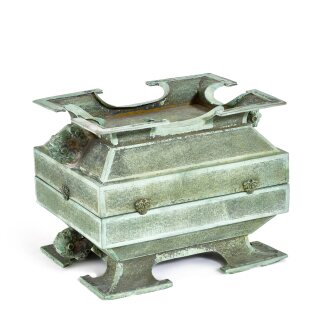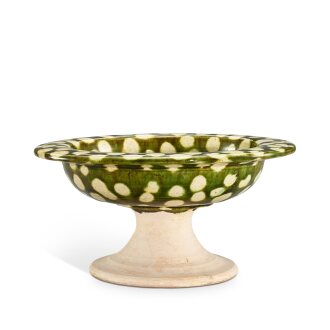C hinese Art Online encompasses a diverse range of early Chinese artworks from a private Asian collection assembled from international auctions and art dealers. The highlight of the sale is a group of archaic bronzes from prominent collections including Eskenazi, Sano Art Museum, Mengdiexuan, Sze Yuan Tang, Muwen Tang and Robert H. Ellsworth. Such treasures are considered the height of metalcraft and artistic expression in an ancient period of history.
Shang and Zhou Dynasties:
Symbols of Power in Archaic Bronze Forms
Each bronze vessel shape had a specific function and fascinating history. Perhaps the most important shape may be the tripod ding, a ritual food cauldron with a deep U-shaped body and supported on three tall legs. This category of vessel features prominently in the legend of China's first dynasty – in which King Yu divided the realm into nine provinces, each represented by one of nine ding. As the dynasty gave way to the Shang and later to the Zhou, the idea of possessing bronze ding had become synonymous with political legitimacy and sovereignty.
Casting and moulding methods during the Shang dynasty marked a significant innovation over the earliest bronze ritual vessels, which were forged by hammer. The new techniques gave rise to more sophisticated, large-scale production, and the development of intricate designs and new forms. The bronze vessels were intended for worship of ancestors, offerings in feast rites, commemoration of important events or various sacrificial ceremonies.
The perfect harmony of form, decoration, and inscriptions on the ritual objects represents the earliest narrative that predates the written word.
Lot 3003 the pair of inscribed 'gong bo' ding represents an unusual sub-group of ding, characterized by its distinctive blade-like zoomorphic legs. The particular group of ding takes inspiration from Neolithic pottery and flourished during the Shang and early Western Zhou dynasties. This symmetry in both form and decorative elements not only offers an aesthetic of balance and proportion, but also suggests a harmony of two realms – a dualism in thought that brings to mind the interaction of art and ritual.
Jue is a wine vessel popular during the Shang dynasty and was used during ceremonial rites for wine libations. The jue has a tripod shape which enables the wine held in the container to be heated. At one end is a long spout to pour wine, and at the opposite end is a pointed tail forming the rim, surmounted by a pair of finials. Lot 3001 is an example cast with two characters reading Fu Yi beneath the handle, which means dedicating this vessel to Fu Yi (Father Yi).
Archaic bronze vessels reflect the spiritual aspirations from the early beginnings of the Shang and Zhou dynasties. While the precise meaning of the objects has obscured through the passage of time, they have become tangible symbols of the interaction between art and ritual. Having an essential function in sacred rites of leadership – of securing harmony between the spiritual and earthly realms – the bronze ritual objects took on the symbolic meaning of political sovereignty and the divine authority bestowed upon ancient rulers.
Highlights of Bronzes from the Eastern Zhou and Han Dynasties

Chariots are deeply ingrained in Chinese culture, they had become one of the most important symbols of status and wealth in China, as chariots could only be used by nobles and high-ranking soldiers.
- Gold-embellished fittings
- Rein-Guide (Yi)
- Horse Trappings (Xian & Biao)
- Horse Chanfron (Danglu)
- Yoke Fittings
- Shaft Finial
- Zoomorphic Fittings
- Drawbar Fittings
-
 A pair of gold sheet-embellished bronze 'mythical beast' chariot fittings, Warring States periodThis pair of exquisite gold sheet-embellished chariot fittings was included in the Eskenazi's 1991 exhibition Inlaid Bronze and Related Material from Pre-Tang China.
A pair of gold sheet-embellished bronze 'mythical beast' chariot fittings, Warring States periodThis pair of exquisite gold sheet-embellished chariot fittings was included in the Eskenazi's 1991 exhibition Inlaid Bronze and Related Material from Pre-Tang China.
VIEW LOT -
 A group of 9 gold and silver-inlaid bronze chariot fittings, Warring States periodFormerly in the Mengdiexuan Collection, this group includes five U-shaped hoops and one trapezial fitting that were used for guiding the rein. These fittings are sumptuously inlaid with gold and silver.
A group of 9 gold and silver-inlaid bronze chariot fittings, Warring States periodFormerly in the Mengdiexuan Collection, this group includes five U-shaped hoops and one trapezial fitting that were used for guiding the rein. These fittings are sumptuously inlaid with gold and silver.
VIEW LOT -
 A group of 13 gold and hardstone-inlaid bronze chariot harness fittings, Western Han dynastyThis group is beautifully embellished with turquoise and agate inlays. The S-shaped fittings (biao) are cheek-pieces for a bridle, each pierced with two slots to receive the straps and to be used together with one snaffle (xian).
A group of 13 gold and hardstone-inlaid bronze chariot harness fittings, Western Han dynastyThis group is beautifully embellished with turquoise and agate inlays. The S-shaped fittings (biao) are cheek-pieces for a bridle, each pierced with two slots to receive the straps and to be used together with one snaffle (xian).
VIEW LOT -
 A pair of gilt-bronze 'dragon' horse chanfrons, Warring States period - Han dynastySplendidly chased with dragon motifs, this pair of gilt-bronze horse frontlets were designed to protect the horse's face.
A pair of gilt-bronze 'dragon' horse chanfrons, Warring States period - Han dynastySplendidly chased with dragon motifs, this pair of gilt-bronze horse frontlets were designed to protect the horse's face.
VIEW LOT -
 A pair of gilt-bronze 'tiger' chariot yoke fittings, Western Han dynastyExcavations have revealed that these intriguing fittings are chariot ornaments once used to crown the curved ends of the yoke that was fitted around the horse's neck.
A pair of gilt-bronze 'tiger' chariot yoke fittings, Western Han dynastyExcavations have revealed that these intriguing fittings are chariot ornaments once used to crown the curved ends of the yoke that was fitted around the horse's neck.
VIEW LOT -
 A rare bronze 'mask' chariot shaft finial, Western Zhou dynasty
A rare bronze 'mask' chariot shaft finial, Western Zhou dynasty -
 A pair of gold and silver-inlaid bronze 'dragon' chariot fittings, Warring States periodThis pair of zoomorphic fittings are formerly in the Feng Wen Tang Collection; the bodies of the beasts are lavishly decorated with gold and silver inlays.
A pair of gold and silver-inlaid bronze 'dragon' chariot fittings, Warring States periodThis pair of zoomorphic fittings are formerly in the Feng Wen Tang Collection; the bodies of the beasts are lavishly decorated with gold and silver inlays.
VIEW LOT -
 A pair of silver-inlaid bronze 'bird' chariot fittings, Western Han dynasty
A pair of silver-inlaid bronze 'bird' chariot fittings, Western Han dynasty
Exoticism in the Tang Dynasty
The Tang dynasty represents one of the most glorious chapters of China’s history when the country was open to and fascinated by influences beyond its boundaries. New desires were kindled and a stream of novel visual stimuli was imported via the Silk Road. Indicative of the trade route's incredible breadth, the two-hump Bactrian camels, as portrayed in lot 3004, were the preferred means of transport for traders as they were capable of travelling farther distances than the single-hump Arabian camels.

The cosmopolitan nature of the culture is also evident in the extravagant pottery figures commissioned for royal and aristocratic tombs. Production and ownership of these rarified glazed figures were restricted to north China, largely in the areas around the capital cities of Luoyang and Chang’an. This flamboyant interpretation of these guardian figures, as portrayed in lot 3002 and lot 3007, derives from Buddhist art in India. It epitomizes the Tang elite’s admiration of exoticism during the height of its power over Silk Road trade routes. The magnificent mythical figures represent both technically and aesthetically the peak of Chinese tomb figures produced during the Tang dynasty.




































